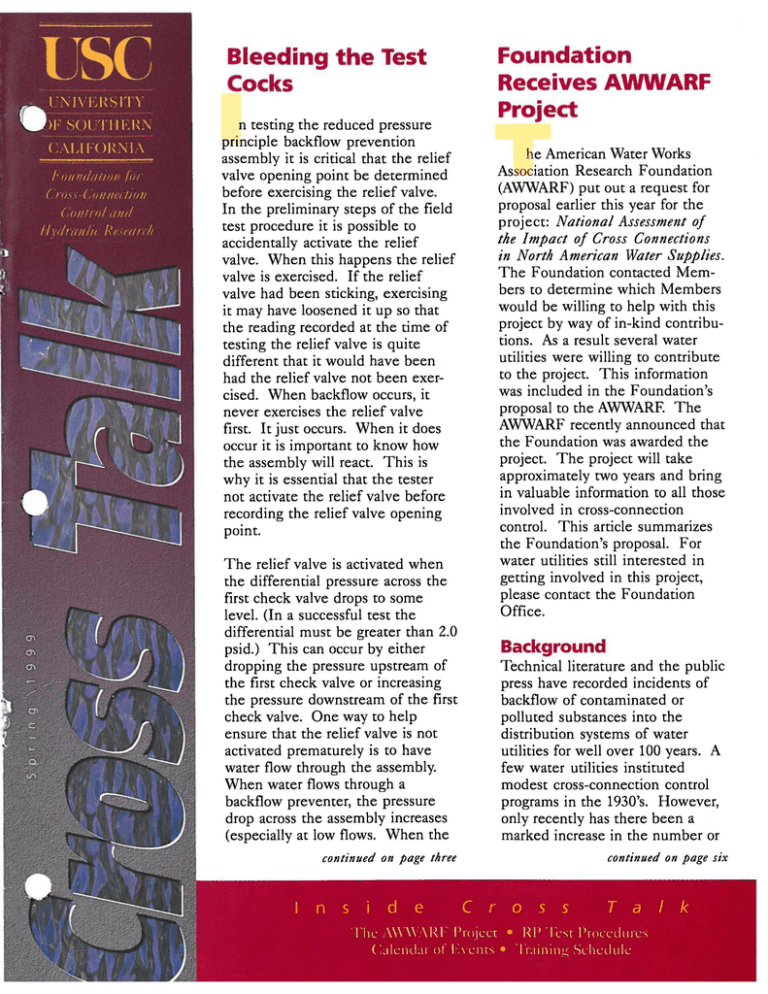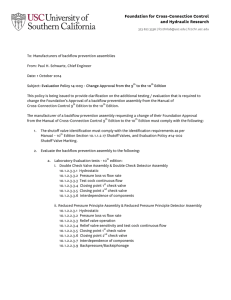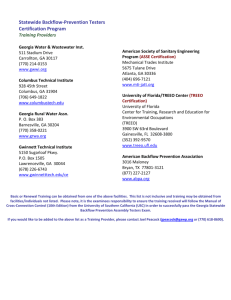Foundation Bleeding the Test Receives AWWARF Cocks
advertisement

Bleeding the Test Cocks n testing the reduced pressure principle backflow prevention assembly it is critical that the relief valve opening point be determined before exercising the relief valve. In the preliminary steps of the field test procedure it is possible to accidentally activate the relief valve. When this happens the relief valve is exercised. If the relief valve had been sticking, exercising it may have loosened it up so that the reading recorded at the time of testing the relief valve is quite different that it would have been had the relief valve not been exercised. When backflow occurs, it never exercises the relief valve first. It just occurs. When it does occur it is important to know how the assembly will react. This is why it is essential that the tester not activate the relief valve before recording the relief valve opening point. The relief valve is activated when the differential pressure across the first check valve drops to some level. (In a successful test the differential must be greater than 2.0 psid.) This can occur by either dropping the pressure upstream of the first check valve or increasing the pressure downstream of the first check valve. One way to help ensure that the relief valve is not activated prematurely is to have water flow through the assembly. When water flows through a backflow preventer, the pressure drop across the assembly increases (especially at low flows. When the continued on page three Foundation Receives AWWARF Projed he American Water Works Association Research Foundation (AWWARF) put out a request for proposal earlier this year for the project: National Assessment of the Impact of Cross Connections in North American Water Supplies. The Foundation contacted Members to determine which Members would be willing to help with this project by way of in-kind contributions. As a result several water utilities were willing to contribute to the project. This information was included in the Foundation's proposal to the AWWARF. The AWWARF recently announced that the Foundation was awarded the project. The project will take approximately two years and bring in valuable information to all those involved in cross-connection control. This article summarizes the Foundation's proposal. For water utilities still interested in getting involved in this project, please contact the Foundation Office. Background Technical literature and the public press have recorded incidents of backflow of contaminated or polluted substances into the distribution systems of water utilities for well over 100 years. A few water utilities instituted modest cross-connection control programs in the 1930's. However, only recently has there been a marked increase in the number or continued on page six he Foundation's Membership Program provides many benefits t the Members of the Foundation. These include: twenty percent discounts on Foundation Training courses for any employee of the Member company/ organization, the List of Approved Backf/ow Prevention Assemblies, printed quarterly, and access to the up-to-the-minute version of the List for those Members with Internet access. Members are encouraged to call the Foundation with technical questions. The Foundation's Engineering Staff is available to assist Members with the various aspects of field testing backflow prevenrers, installing backflow preventers, administering their cross-connection control program. ABPA - Indiana Chapter Albuquerque Techn ical Vocationallnst. Allied Associates Consulting Engineers Allied Signal American Backflow Prevention, IL Anytime Plumbing Arizona Chapter, ABPA Austin, City of Automatic Rain Company Backflow Services Backflow Solutions Inc. Brooks AFB Brunswick County Pub. Uti!. Central Community College Desert Botanical Garden Douglas County Ellensburg, City of Environmental Care, Inc. Fern Valley Water Dist. Fernley Utilities Florida Plumb. Appren. Assoc. Franklin, City of Gering, City of Govero, Steve lntervalve Corporation JPH Engineering Lake Cities M.U.A. Lea Watson Backflow Prev. Serv. Lama Linda Public Works, City of Long Beach Water Department Mark Conklin Metropolitan Water District - Glendora Office Michael Sciarabba Plumbing Mid-America Marketing Navy Public Works Ctr. Miramar NKWSD Oak Mechanical Serv1ces Plumbers Local Un ion #433 RBF & Associates SAH Training/Seminars Southern Calif. Backflow Cont. Sundance Irrigation Training Toccoa, City of U.A. Local 375 J.A.T.C. Union Carbide Corporation Contacting the Foundation Mailing Address: Foundation for CrossConnection Control and Hydraulic Research University of Southern California Kaprielian Hall 200 Los Angeles, CA 90089-2531 Phone: 213 740 2032 FAX: 213 740 8399 e-mail: fccchr@usc.edu Web Site: www. usc.ed u/fccch r The Foundation accepts Purchase Orders via mail or fax and credit card orders (Visa, MasterCard, Discover) via telephone and the Web. Cross Talk is published by the Foundation for Cross-Connection Control and Hydraulic Research at the University of Southern California for Foundation Members. Limited additional copies are available to Members upon request. (213) 740-2032 1999 ©University of Southern California. All rights reserved. Q Bleeding the Test Cocks ...... .,_ continued from page one l ••< Because of the pressure loss characteristics of backflow preventers, the possibility of activating a relief valve can be reduced substantially if flow is established through the assembly during certain preliminary steps in field testing. This is why there is a very specific order for bleeding the test cocks on the reduced pressure principle assembly. Step a of Test No. 1 in Section 9.2.2 of the Manual of CrossConnection Control, Ninth Edition states: Open No. 4 test cock to establish flow through the unit, then flush water through test ---- cocks N o. 1, No.2, (open No. 2 test cock slowly), and No. 3, by opening and closing each test cock one at a time, to eliminate foreign material. Be careful not to activate the relief valve during this process. C lose test cock N o.4. pressure drop across the whole assembly increases, this is also an indication that the pressure drop across the first check valve increases. This is an indication of the force being used to open the check valve. At a no-flow condition, the pressure drop across the assembly is steady. As water starts to flow through the assembly more pressure is lost due to friction loss and the opening of the check valves. Once the check valves are opened a fair amount there is less force required to keep them open. This is why the flow curves of the various backflow preventers tend to have similar characteristics. One thing consistent in all flow curves is the increase in pressure loss as the flow increases from a no-flow condition. .. As water flows out of the No.4 test cock it is flowing through the assembly, thus increasing the continued on page four .: . · ... . : .:·· ... : ···. . . the pressur . /::. principl . . . ·. . t ·. : : backfl ::.:.. - ...... . :· . .. : ... : • •~ • ~ r 6 4 2 :··· open ng point ·_-=~~~~-;-~~~~21jb;e termined befd re ising the - -Hl.l19f valve. Bleeding the Test Cocks In order to avoid premature activation of the relief valve in this manner, the Manual of CrossConnection Control states that the tester should open the No. 3 test cock and bleed water from the low side of the gage while opening the No.2 test cock very slowly. continued from page three pressure loss across the No. 1 check valve. This reduces the possibility of activating the relief valve dramatically. This is especially important while opening the No. 2 test cock. The No. 2 test cock is located at a place on the assembly upstream of the number one check valve. Opening this test cock may reduce the pressure upstream of the No. 1 check valve. If this is done suddenly the pressure differential across the No. 1 check valve can drop, discharging the relief valve. This is especially critical when the No. 2 test cock is located in a restricted region on the high side of the relief valve diaphragm as shown in the illustration. If, however, water is flowing through the assembly when the No. 2 test cock is opened, the overall differential across the No. 1 check valve is much higher and, therefore, requires a greater loss of pressure m order to activate the relief valve. l_! This is why ,. it is so important to have water flowing through the No.4 test cock when the No.2 test cock is opened. 1 . . .. Bleeding the test cocks is not the only way the relief valve can be activated accidentally. Bleeding the air from the gage can cause the same effect. When the gage is attached to the assembly, the high side hose is attached to the No. 2 test cock. Therefore, bleeding water from the high side hose, could cause the same effect as bleeding the No. 2 test cock. In order to avoid premature activation of the relief valve in this manner, the Manual of CrossConnection Control states that the tester should open the No. 3 test cock and bleed water from the low side of the gage while opening the No. 2 test cock very slowly. Section 9.2.2 Test f: Maintain the low side bleed needle valve in the open position while test cock No. 2 is opened slowly. This, again, allows water to flow through the assembly keeping the differential across the No. 1 check valve high. The water continues to flow through the low side bleed needle valve until the No. 2 test cock is opened and the high side bleed needle valve is bleed. The low side bleed needle valve is only turned off after the high side is turned off. This ensures that water will continually be flowing through the unit when pressure is dropped from the chamber upstream of the No.1 check valve. This is an example of how important it is to follow proper field test procedures, even though the details of the procedures-on the surface-may not seem to have an impact on the final outcome of the test. In this case, even the order in which the test cocks are bled is "( crucial to obtaining proper field data. ( AWWARF Project continued from page one ' ' programs across North America. Although many cross-connection control programs have been initiated in recent decades, there are many utilities, which either do not have a program or do not have a sufficient program to provide for reasonable protection from crossconnections. Part of this is due to a lack of uniform regulations. Another reason many utilities have not initiated or maintained strong cross-connection control programs is that vast quantities of documented data regarding crossconnections are not readily available. This is mostly due to the nature of backflow. Hydraulic conditions within a piping system change continuously. As a brief example, it is possible for a water main break to cause a drop in system pressure within a region of a water distribution system. Because of crossconnections common to any distribution system, backflow could occur contaminating a portion of the distribution system. As a result of this backflow situation, individuals could ingest the contaminant, or the appearance of water could cause alarm to the water user. Before the source of the contaminant can be discovered, the water main is repaired, water pressure is normalized and the system flushed clean through normal use. This makes it very difficult to document such a backflow incident. Since there is no Federal reporting requirement for cross-connections, national statistics are not available. There are, however, a number of backflow incidents, which have been compiled by the Foundation for CrossConnection Control and Hydraulic Research. Selected portions of this information is published in the Manual of Cross-Connection Control, Ninth Edition. This is by no means all-inclusive, but does give an indication that crossconnections are widespread and nationwide. 1. Objective A comprehensive surv y will be designed for w ter utilities, local and stat governments. The su ey will be designed to de ermine the extent of existing cross-connections wit in utility distribution sys ems as well as within prem se piping systems. Addit onally, the survey will de ermine the extent of cro sconnections, which have been controlled by an effective means of backflow protection. An assessment of best management practices will be made in order to help determine the most etr,ective means of elimina~ng contamination and pollution due to cross-connections, and --~ health provide the greatest puDli' benefit. Three computer models covering large utilities and_small _ ~ '-~ utilities will be developed to ..,.._ ~" simulate backflow and the effec .;.· -"~~~~~~-;ijl[i~~ t...---.. . -=-.. ...:. contimted on page ....six ~'"" ~~ Foundation Receives AWWARF Project The survey will determine the extent of existing cross-connections within utility distribution systems as well as ~it~in premis71'1 p1p1ng systemsll' J wi!JJJ continued from page five of cross-connection con- Survey first tas of the project will be ....,.",'"'"""i~n and conduct a survey '1\C()...~e,rJng a Ia1ge sample of water ~ovef lOOO utilities are concerning the cross~\l.l., ... nJLLIOJlS 'itnd cross-connection le'l'l.r.n't'r.n.'l pracoces and their effec~e survey will quantify ipformation in the f~lowing areas. ost Common Types of -"''"'N.,-Connections s-connection is as follows in the J.rul'""'r-~' of Cross-ConnecContro/, N inth term "cross-conmean any unproL'-'~'"'..._urt'' "t-•'-'11 or potential connecarrangement or a consumer's system and any other through which it introduce into any le system any used I fluid, gas, or other than the intended r with which the · d. Bypass ar- "direct crosson" shall mean a crosswhich is subject to u a.,_.... .,.phonage and b. The term "indirect crossconnection" shall mean a crossconnection which is subject to backsiphonage only. The survey will determine which types of cross-connections (i.e., direct, or indirect) are most prevalent in distribution systems as well as within user premises. The analysis of this data will determine if specific types of cross-connections are more prevalent in specific geographic regions, or types of systems. Additionally, the types of cross-connections most commonly found in distribution systems will be compared and contrasted with types of cross-connections most commonly found in internal on-premise water systems. 2) History of Backf/ow Incidents A comprehensive analysis of data provided from the survey will determine the history of backflow incidents, which have occurred in water distribution systems and onpremise systems. The analysis will determine if there is a correlation between backflow incidents and efforts on behalf of the administrative authority to abate crossconnections. 3) Financial Impacts The financial impacts of backflow incidents will be analyzed including incident response, investigation, clean-up and repair. This information will be valuable to water utilities in determining the ramifications of allowing crossconnections to go unabated. This information will also be analyzed contrasting on-premise incidents to system incidents. \4) Hydraulic Changes within a Distribution System .. ~ The survey will determine the hydraulic changes within a water distribution system and the changes' potential to create backflow conditions. Changes in system pressures change the direction of the flow of water, by varying high and low pressure regions within a system. A comprehensive analysis of how this affects the potential for backflow will be conducted. Comparisons will be made to see if there are differences based on the age of the water systems, the region of North America, the time of day and the season of the year. As a follow up to a written survey, a physical survey of a sample of water systems may be deemed necessary. Battery operated pressure recorders can be installed at various locations in different water systems to get more comprehensive data. This information can be compared with the historical data on backflow incidents to identify patterns of backflow occurrence under certain hydraulic conditions within the system. Ultimately, this information will help administrative authorities prioritize their backflow prevention program based on hydraulic conditions in the system. 5) Assessment of the Occurrence of Backpressure and Backsiphonage An assessment of the data obtained will show any correlation between the type of backflow, which occurs (i.e., backpressure or backsiphonage) and various water systems and communities. 6) Types of CrossConnection Control Programs A detailed analysis of cross-connection control programs will determine the major elements of an effective cross-connection control program . The types of programs in effect combined with other elements of the survey will show which specifi c aspects of a program provide the greatest public health benefi t .. This information will also determine if specific aspect , such as public education are helpful in bringing about compliance. An analysis of the effectiveness of internal protection verses system protection will be conducted. This wi ll be helpful in determining whether one type of crossconnection control program i more effective than another in protecting the potable water supplies. Or, whether both aspects are necessary to ensure the quality of the water within the distribution system'>. 7) Regulations and Enforcement Issues The next issue of The common aspects of th e most effective regulations will be i'iolated from the survey data. The most effective means of enforcement wil l also be determined. \· nether or not a public relations program assists in th t: overall enforcement of a program " ill be determined as well as wh at effect public education has on the enforcement capability of a progra m. The effectiveness of guidance man ual'i, specific policies and procedu res will also be assessed. discuss the remaining points of the survey and the other aspects of the project. Any water utilities desiring to participate in the project, should contact the Foundation office. Cross Talk will aining Co rses Tester Course Las Vegas, NV 13-17 September 1999 .. L os Angeles, CA 24-28 January 2000 l L os Angeles, CA 15-19 May 2000 L os Angeles, CA 10-14 July 2000 ... Specialist Course l ==== Las Vegas, NV 18-22 October 1999 Los Angeles, CA 7-11 February 2000 Los Angeles, CA 13-17 March 2000 - Los Angeles, CA 24-28 July 2000 ~ UNIVERSITY OF SOUTHERN C.\LIFOR.' \IA Joint Instrumentation Conference •Santa Ana, CA 18 August 1999 Inland Counties Backflow Group •San Bernardino, CA 15 September 1999 l ·-' Northern California Backflow Prevention Association • Pleasanton, CA 26 August 1999 AWWA Distribution Systems Symposium •Reno,NV 21 September 1999 ) Tri-State Seminar • Laughlin, NV 23-25 September 1999 Western Regional Backflow Conference • Las Vegas, NV 4-6 October 1999 ' Manual Review Committee Open Meeting • Los Angeles, CA 12 October 1999 I usc Upcoming Events l tl 1 Foundation for Cross-Connection Control and Hydraulic Research School of Engineering University of Southern Califo rn ia Kapriehan Hall 200 Los Angeles, Californ ia 90089-253 1 First C!ass US Postage PAID University of Southern Californ ia


